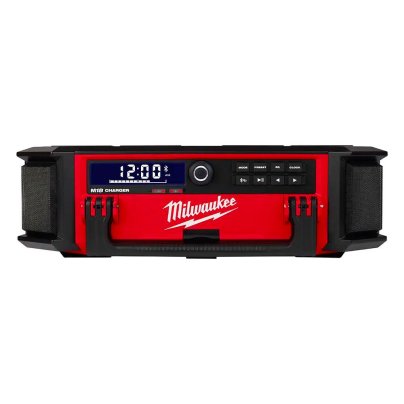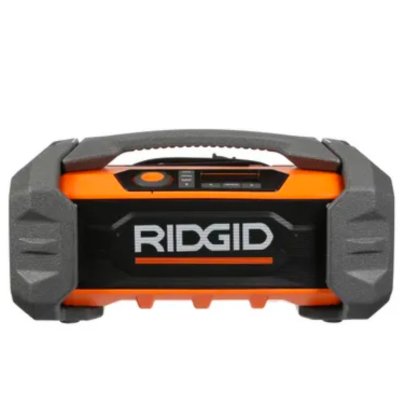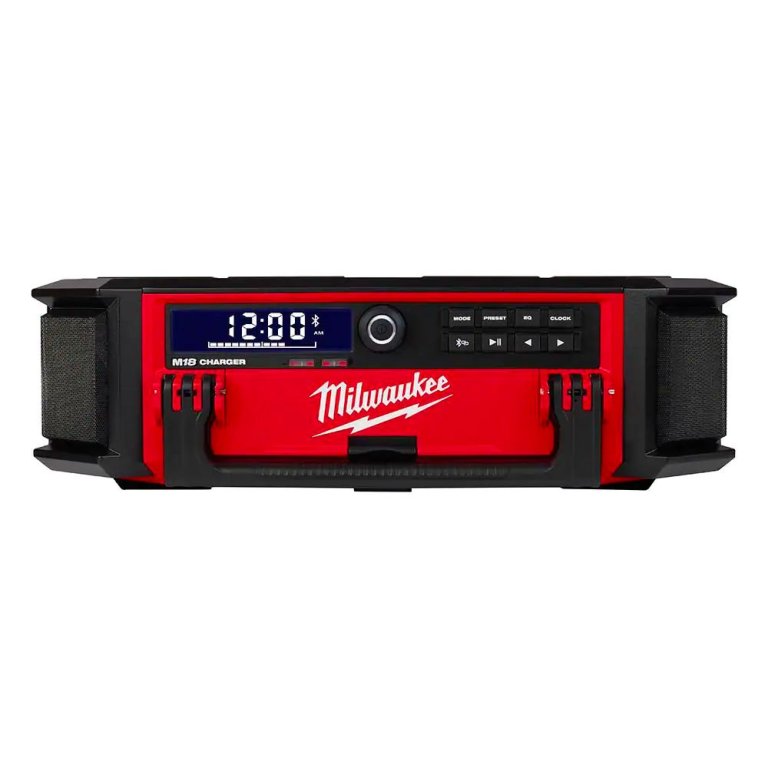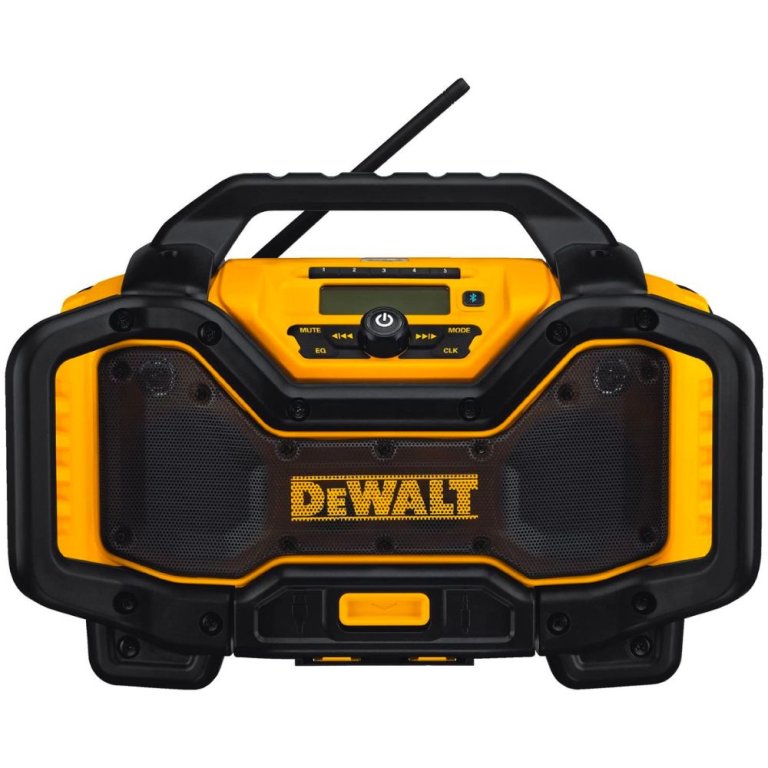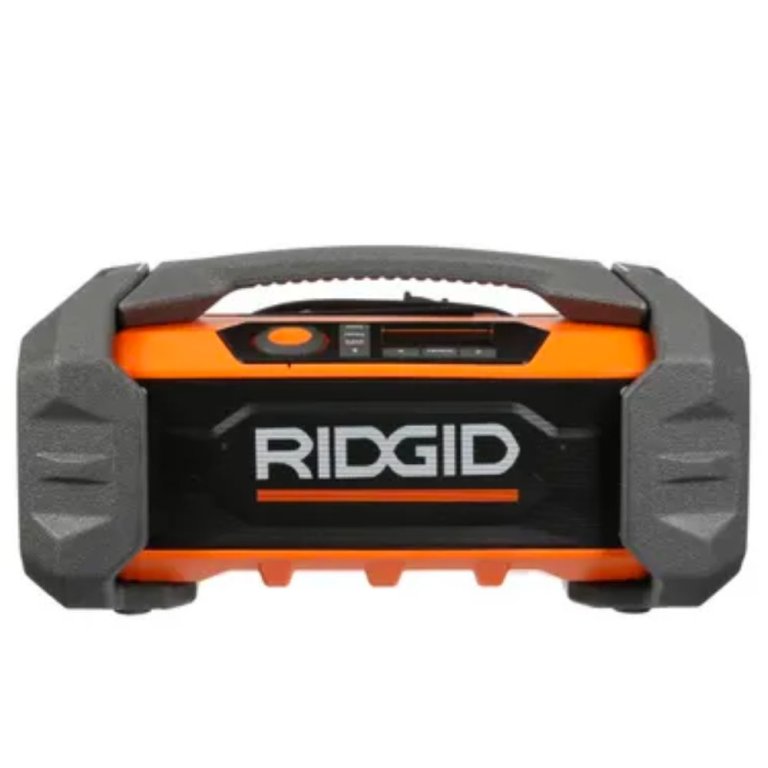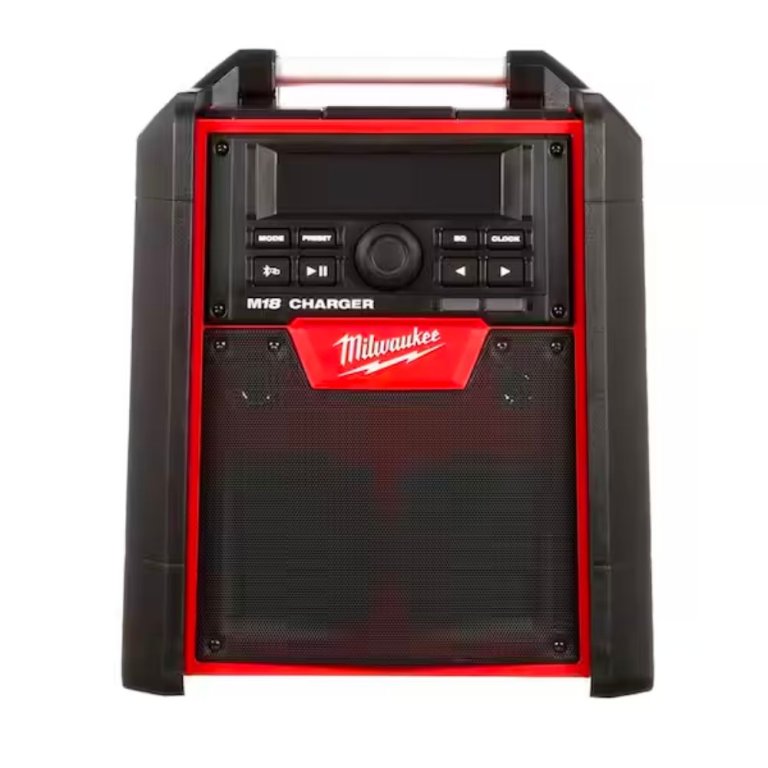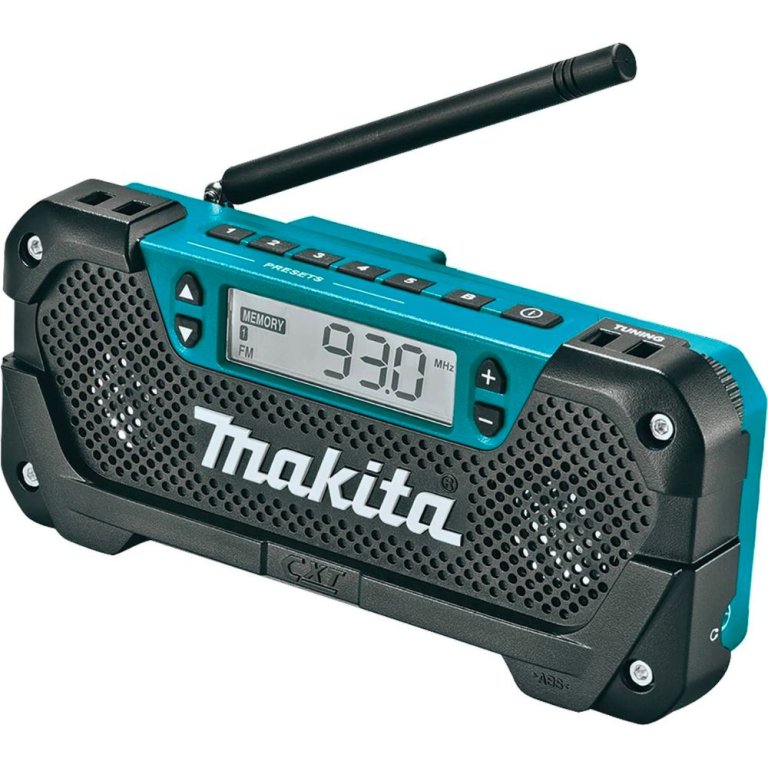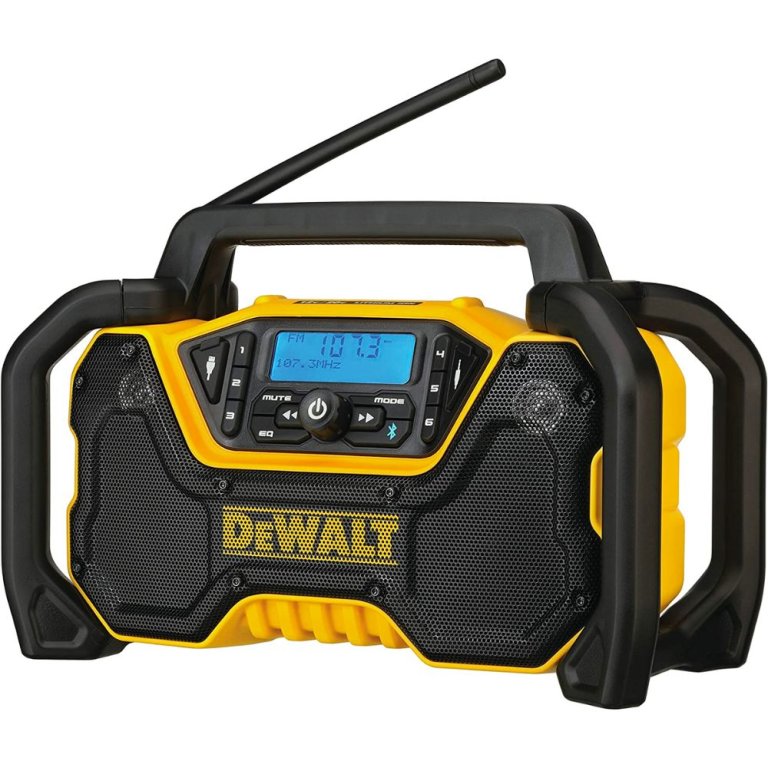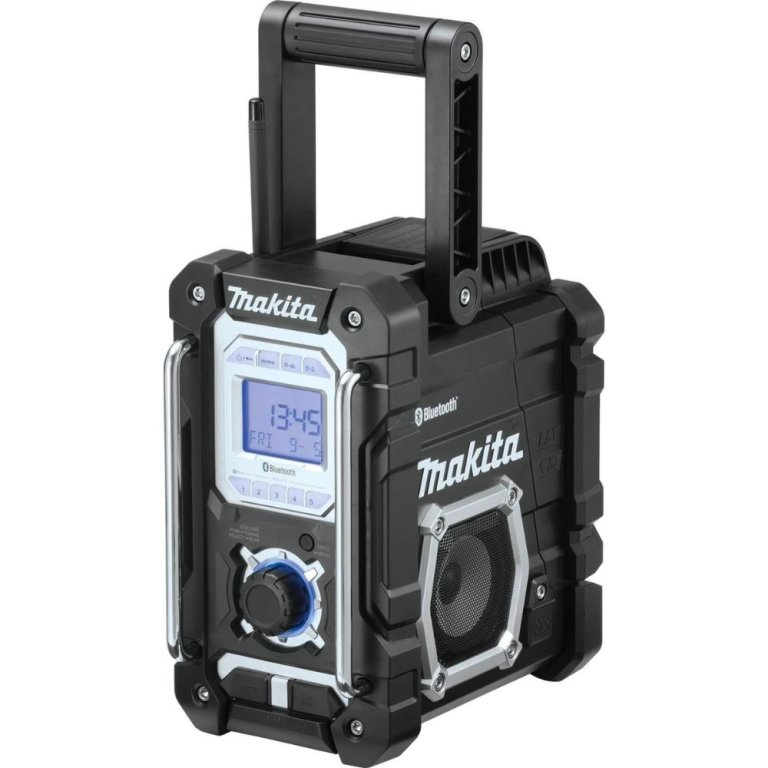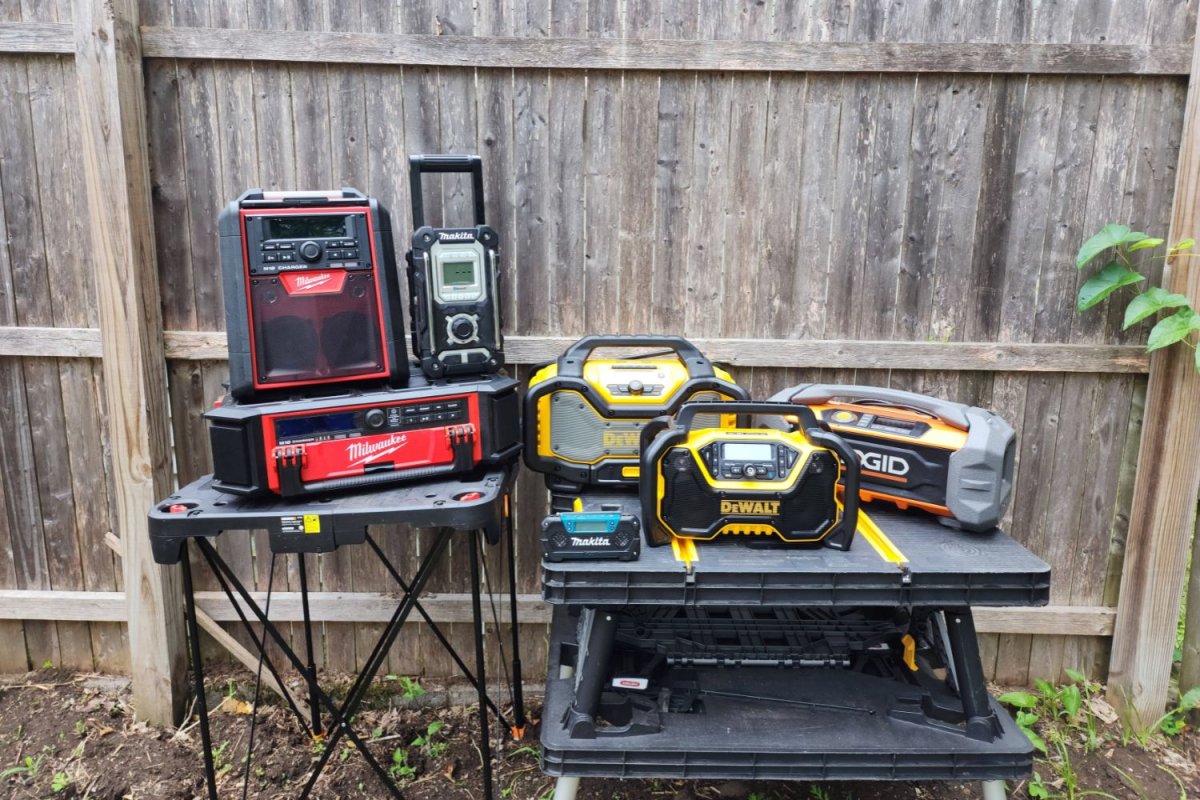
We may earn revenue from the products available on this page and participate in affiliate programs. Learn More ›
Jobsite radios are tougher than ordinary radios. They’re built to take abuse on a near-daily basis and still keep cranking out tunes. They might face billowing clouds of drywall dust, a sudden downpour, or a hard fall if inadvertently kicked over. But because music can make a day go by faster and keep you focused, a jobsite radio is a go-to piece of gear if you spend long days working.
The best jobsite radio should be waterproof, shock-resistant, able to run on electricity or batteries, and have powerful speakers so you can hear your music over the roar of tools. Some jobsite radios do more than play music—they can also provide storage for small items and charge cell phones and cordless tools.
To help make the shopping process for these radios a bit easier, we performed hands-on testing with the following models. We put them through their paces to see (and hear) what they could do. Keep reading to learn what we found when using each of the following radios.
- BEST OVERALL: Milwaukee 2950-20 M18 PACKOUT Radio + Charger
- RUNNER-UP: DeWalt DCR025 Bluetooth Charger Radio
- BEST BANG FOR THE BUCK: Ridgid R84087 18V Jobsite Radio With Bluetooth
- BEST SOUND QUALITY: Milwaukee 2792-20 M18 Jobsite Radio/Charger
- BEST COMPACT: Makita RM02 12V Max CXT Compact Jobsite Radio
- BEST IMPACT-RESISTANT: DeWalt DCR028B 12V/20V MAX Bluetooth Jobsite Radio
- ALSO CONSIDER: Makita XRM06B 18V LXT Lithium-Ion Jobsite Radio
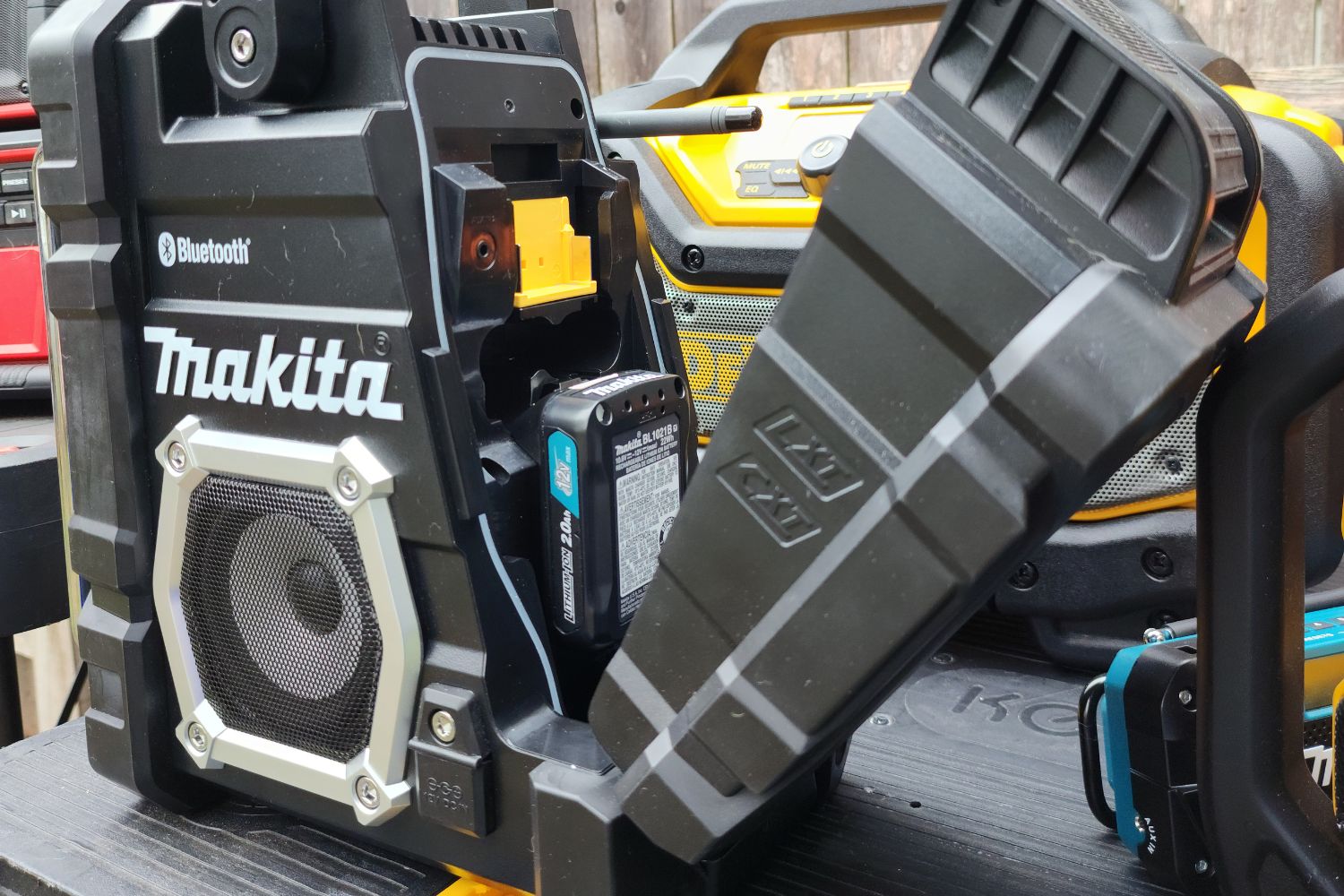
How We Tested the Best Jobsite Radios
We wanted to ensure that every jobsite radio we suggested would meet the rigors of a project site, so we put several models through hands-on testing. We spent a day with each radio, using them on projects and testing their charging capabilities. We even brought them to baseball practices and tournaments to ensure they could handle rough, dusty, and wet conditions.
Through our testing, we identified each model’s strengths and weaknesses. We judged battery life, sound quality, durability, and functionality. While each model had its pros and cons, we felt each of the above models was worth the investment for the right folks. We gave them awards based on their most significant strengths, but we also point out where they fell a bit short.
Our Top Picks
Here’s a list of our favorite jobsite radios, established through days of hands-on testing to ensure they could meet the needs of a project site.
Best Overall
Milwaukee 2950-20 M18 PACKOUT Radio + Charger
Pros
- Runs on AC power or battery power and charges M18 batteries and mobile devices when plugged in
- Features 10 speakers in a 360-degree layout to project music all around
- Speakers produced excellent sound quality, and it features a tunable equalizer
- Connects to the Milwaukee M18 PACKOUT system for organization and easy transport
Cons
- Can be a bit heavy to carry when not attached to the PACKOUT tool chest
- FM static intensifies if the radio is playing while a battery is charging
Product Specs
- Bluetooth capability: Yes
- Size: 22 inches long by 6.75 inches wide by 16.25 inches deep
- Weight: 23 pounds
- Charging: Yes, Milwaukee M18 batteries and mobile devices
Construction pros, DIYers, and anyone else who needs a rugged, portable radio will want to consider the Milwaukee M18 PACKOUT radio and charger. This model from Milwaukee attaches to the brand’s PACKOUT tool storage system, allowing you to roll it to the project site on top of a wheeled tool box. It also runs on the brand’s M18 batteries or a standard AC plug. It can charge a mobile device when in battery-only mode, but it will also charge M18 batteries when plugged into an AC outlet.
The Milwaukee features 10 speakers, including four tweeters, four full-range speakers, a subwoofer, and a resonator. Their placement also allows this jobsite radio to project sound in a 360-degree range to fill an entire jobsite with sound. It has AM and FM radio, Bluetooth, and an auxiliary input. It even features a built-in bottle opener for after-work beverages.
Off the bat, let’s get the complaints out of the way: We found this model to be large and heavy, so it really does best when attached to the PACKOUT wheeled tool chest. Also, FM static intensifies when it’s in charging mode. Beyond those two complaints, though, we found this jobsite radio incredible. It’s loud, provides excellent sound quality, and even features a handy weathertight storage area for cell phones and other small items. With the volume cranked up, it lasted for more than 8 hours on a 5-amp hour (Ah) battery.
Read our full review: Milwaukee 2950-20 M18 PACKOUT Radio + Charger
Get the Milwaukee 2950-20 jobsite radio at The Home Depot, Northern Tool + Equipment, or Acme Tools.
Runner-Up
DeWalt DCR025 Bluetooth Charger Radio
Pros
- Runs on or charges the brand’s popular 20V and 60V Max batteries
- Weathertight compartment offers safe storage for a mobile phone or wallet
- Sound quality is excellent and will please music lovers or those wanting to listen to talk radio or a podcast
Cons
- Some connectivity issues when using Bluetooth
- LCD screen was difficult to read unless you’re standing at the perfect angle
- Device controls do not include a pause button
DeWalt’s DCR025 bluetooth charger radio might be the top choice for certain folks, such as those already invested in the DeWalt tool lineup. This radio and charger can run off 20V or 60V Max batteries, or you can plug it into a standard AC wall outlet. When plugged in, it can charge both batteries and mobile devices. In battery-only mode, it will charge mobile devices but not batteries. The DeWalt has onboard cord storage and a large weather-sealed compartment for mobile devices and other small valuables.
This model will play music, talk shows, or podcasts through the AM/FM radio, Bluetooth connectivity, or auxiliary input. It also has a USB port, but this is only for charging devices. It also has two AC outlets on the side of the radio that work when the radio is plugged into a wall outlet.
The DeWalt DCR025 proved to be a great jobsite radio during testing. On the not-so-great side, the LCD screen was tough to read unless we were at the perfect angle, and even then, it wasn’t very clear. We also had a few Bluetooth connectivity issues where our phone would connect, but the speaker would not play sound (it would allow us to rewind or skip songs, however). It doesn’t have a pause button, which seems like a major oversight. However, the sound quality was very good, and the radio itself is very loud when cranked all the way up. We also like that it features large plastic handles that act as a roll cage to keep it safe. The weathertight compartment is also a nice touch, as it can store a large phone or wallet. Also, since so many pros and DIYers are invested in DeWalt tools, they’re likely to have a slew of batteries to use with this jobsite radio, and we appreciate that type of convenience and value.
- Bluetooth capability: Yes
- Size: 18.25 inches wide by 11 inches deep by 12.75 inches tall
- Weight: 15 pounds
- Charging: Yes, 20V and 60V Max batteries and mobile devices
Get the DeWalt DCR025 jobsite radio at Amazon, Lowe’s, or The Home Depot.
Best Bang for the Buck
Ridgid R84087 18V Jobsite Radio With Bluetooth
Pros
- Affordable price point allows you to bring a rugged jobsite radio to work without a huge investment
- Over-molded shell is hollow, protecting the radio without being unnecessarily heavy
- Lightweight design makes it is easy to transport back and forth to the jobsite
Cons
- Audio quality isn’t as good as most of the other models in the test
Product Specs
- Bluetooth capability: Yes
- Size: 18.5 inches wide by 9.2 inches deep by 9.5 inches tall
- Weight: Not listed
- Charging: Yes, 18V Ridgid batteries and mobile devices
Getting tunes at the jobsite doesn’t have to break the bank. With an affordable price point, the Ridgid R84087 18V Bluetooth jobsite radio could be a good fit for most budgets. This radio can run off Ridgid’s 18V batteries or AC outlet power, and it can also charge those batteries plus mobile devices. It has an AM/FM radio, Bluetooth, and an auxiliary port, as well as a USB port for charging devices.
The Ridgid’s tough, sealed outer shell helps protect it from dust, dirt, and the elements. However, that over-molded shell is actually hollow, allowing this model to remain semi-lightweight.
We found the overwhelming benefits of the Ridgid jobsite radio are its price point and relative light heft (the actual weight is unlisted, but we estimate that it’s around 10 pounds). The audio quality isn’t very impressive, but it is likely suitable for a jobsite. It is loud, but the quality does break up at high volume. We did appreciate the over-molded shell for the protection it provides to the radio without being excessively heavy.
Get the Ridgid jobsite radio at The Home Depot or Amazon.
Best Sound Quality
Milwaukee 2792-20 M18 Jobsite Radio/Charger
Pros
- 40-watt amplifier ensures that this radio/charger combo produces excellent-quality sound
- Equalizer allows you to dial in the perfect bass and treble settings for customizable sound
- Built-in metal handles also act as a roll cage to protect the unit on a jobsite
Cons
- Weatherproof compartment is a little small for larger mobile devices
Product Specs
- Bluetooth capability: Yes
- Size: 12 inches wide by 12 inches deep by 15 inches tall
- Weight: 17 pounds
- Charging: Yes, any M18 batteries and mobile devices
For those who prefer their music or podcast to be crystal clear, the Milwaukee M18 Jobsite Radio/Charger might be the best option. This powerful radio and charger combo features a 40-watt amplifier that produces loud, clear sound quality. It also features a customizable equalizer that lets you dial in bass and treble settings.
This Milwaukee radio and charger combination works on both AC power and any of the brand’s M18 batteries. It also charges those batteries when plugged in, and it can charge mobile devices in both cordless and corded modes. It has AM/FM radio, Bluetooth, and auxiliary modes, as well as a USB port that provides device charging. There is a weatherproof storage compartment in the top of the radio unit, as well as a built-in bottle opener and three durable metal handles that also act as a roll cage.
Overall, it was hard to place this radio and charger combination anywhere other than the top spot, but since it doesn’t connect to any fancy tool boxes, it makes more sense to recognize it for its excellent sound quality. It’s loud, clear, and provides plenty of adjustability in terms of bass and treble. We did find that the storage compartment was a bit small for anything other than a very small phone—however, the USB port charged our mobile devices very quickly, and the compartment door acts as a stand for phones, so the trade-off is reasonable.
Get the Milwaukee 2792-20 jobsite radio at The Home Depot or Northern Tool + Equipment.
Best Compact
Makita RM02 12V Max CXT Compact Jobsite Radio
Pros
- Compact size and lightweight design allow you to keep it on hand at all times
- Built-in hook allows you to hang it from your tool belt or a bracket
- Impact-resistant, so it should be able to take a few drops or bumps
Cons
- Sound quality and reception are both lacking, so it’s best for sports games or talk shows
Product Specs
- Bluetooth capability: No
- Size: 6.63 inches long by 2.25 inches deep by 2.75 inches tall
- Weight: 1.7 pounds
- Charging: No
If you need a compact radio to break out on the jobsite so you don’t miss the news or game, the Makita RM023 12V Max CXT compact jobsite radio is worth a shot. This model weighs just 1.7 pounds and is under 7 inches long, so it’s a fraction of the size and weight of most jobsite radios. You can stow it in a tool box or slip it in a pouch on a ladder brace or tool belt with a built-in hook.
It plays AM and FM radio stations and comes with an earphone jack for listening to the game without bugging others. The Makita also has an auxiliary jack for plugging in an MP3 player or an iPod, but it’s not Bluetooth-capable. The body of the Makita is impact-resistant to protect against bumps and small falls.
We keep mentioning news or games because the sound quality on this radio is lacking; it’s no better than an 80s countertop radio. Reception can also be a challenge. And since fewer and fewer phones are coming with headphone jacks, the auxiliary port isn’t a particularly useful feature. However, the radio can fit just about anywhere and runs off the brand’s 12V batteries (which are also compact), so keeping it nearby for a little background noise might be worth it to some shoppers. The built-in hook is also helpful, as you can hang it from a belt or bracket.
Get the Makita RM02 jobsite radio at Amazon or The Home Depot.
Best Impact-Resistant
DeWalt DCR028B 12V/20V MAX Bluetooth Jobsite Radio
Pros
- Compact design makes it lightweight and easy to carry without sacrificing sound quality
- Dual 3.5-inch woofer and 1-inch tweeters ensure it has a full range of quality sound
- Built-in roll cage and lightweight design ensure it’s durable and can handle jobsite rigors
Cons
- Doesn’t charge DeWalt batteries, so you’ll need to have charged batteries on hand
- No onboard storage for the included detachable power cord
Product Specs
- Bluetooth capability: Yes
- Size: 8.2 inches wide by 15.75 inches deep by 10.8 inches tall
- Weight: 8.25 pounds
- Charging: No
Folks looking for small but rugged jobsite radio will not be disappointed with the DeWalt DCR028B 12V/20V Max Bluetooth jobsite radio. This model features large over-molded handles that also act as an integrated roll cage. Coupled with the radio’s small size and lightweight design, it’s both durable and convenient to transport.
This small radio features two 3.5-inch woofers and two 1-inch tweeters for high-quality sound. It has an AM/FM receiver, Bluetooth, and an auxiliary input. It also has a USB port, but this port only charges devices. It comes with an AC adapter for wall outlets and runs on 12V or 20V Max batteries. However, it does not charge them.
To our surprise, this radio sounded great for its size. We liked that it can use two different battery types, but we didn’t like that it doesn’t charge them. Its compact and lightweight design was also a huge plus, and it doesn’t sacrifice sound quality for size. Unfortunately, there isn’t onboard storage for the AC plug, but the built-in roll cage ensures it can handle tough jobsite conditions.
Get the DeWalt DCR028B jobsite radio at Amazon, Lowe’s, The Home Depot, or Acme Tools.
Also Consider
Makita XRM06B 18V LXT Lithium-Ion Jobsite Radio
Pros
- Can function with most of Makita’s cordless battery types, including 7.2V, 12V, 14.4V, and 18V batteries
- High-quality sound from speakers on either side of the jobsite radio
- Programmable alarm clocks to help you get to work on time or notify you about lunch
Cons
- Works with lots of different batteries but will not charge them
- No onboard cord storage, and there isn’t room inside the clamshell cover with a battery installed
- No forward-facing speakers, so sound projection is a little strange
Product Specs
- Bluetooth capability: Yes
- Size: 6.375 inches wide by 10.375 inches deep by 11.625 inches tall
- Weight: 10.65 pounds
- Charging: No
For DIYers and pros invested in the Makita power tool lineup, the Makita jXRM06B jobsite radio might be the way to go. This model can run on 7.2V, 12V, 14.4V, and 18V batteries, ensuring that there’s always a battery to run it (a good thing too, since it doesn’t charge). Batteries connect into one of several ports inside the clamshell-style cover, though only one battery can connect at once.
This jobsite radio plays AM/FM radio channels and syncs with Bluetooth-enabled devices to stream music. It also has an auxiliary port for an MP3 player or iPod, as well as a USB port for charging devices. It has speakers on the left and right of the device, and it’s dust- and water-resistant. The LXT does not charge cordless batteries, but it does come with an AC adapter for plugging the radio into an electrical outlet.
There are ups and downs to this model, so we can really only suggest it to Makita owners. First, the clamshell cover is great, but it doesn’t have room for the power cord when there is a battery installed, so there isn’t any onboard storage. Also, there aren’t any forward-facing speakers, so the sound quality is only good if you’re to the left or right of the stereo. Its battery flexibility is wonderful, but only one battery can be installed at a time, so swapping out batteries will become a pain. It does have programmable alarm clocks, however, which could help ensure you make it to the jobsite on time or let you know it’s time for lunch.
Get the Makita XRM06B jobsite radio at Amazon or The Home Depot.
Jump to Our Top Picks
What to Consider When Choosing a Jobsite Radio
When shopping for a jobsite radio, there are several factors to consider.
Portability
Jobsite radios are designed to be portable, and most have a handle for easy carrying so you can easily move them around as needed. Depending on the brand and model, a jobsite radio can weigh anywhere from under 2 pounds to 25 pounds.
Durability
Jobsite radios must be durable enough to withstand dirty, tough conditions. Some jobsite radios have protective cages that look like the roll bars on a dune buggy. They protect the radio from being damaged if it falls or gets knocked over. Some models are advertised as being able to support the weight of a person standing on them without breaking.
Waterproofing
Jobsite radios can typically withstand a thunderstorm, but don’t drop one in a swimming pool and expect it to work. This is because they have a durable outer case that makes them water-resistant, but they are usually not waterproof. However, the best jobsite radios often incorporate some waterproof features, including flip-up doors that cover USB charging ports and sealed compartments for holding batteries, phones, or keys.
Battery Life and Type
Most jobsite radios operate on AC power from an electrical outlet but also run on battery power. While standard radios run on AA, AAA, or 9-volt batteries, jobsite radios usually run on the same large batteries used to power cordless tools, which tend to be brand-specific. For example, a DeWalt jobsite radio will run on only DeWalt cordless batteries, and a Makita jobsite radio will run on only Makita cordless batteries. Most jobsite radios are made by manufacturers of cordless power tools, and the batteries that power the tools will also power the radios.
Battery life varies by the voltage of the battery. Typical voltages include 12 volts, 18 volts, and 20 volts. The higher the voltage, the longer the battery life. In general, you can expect 25 to 35 hours of tune-playing time on a cordless battery before recharging.
Charging Capability
Some jobsite radios can charge other items, such as cordless power tools or the batteries that operate them. This option is desirable because you can listen to music while charging a battery for a saw or a drill.
Many jobsite radios feature one or more USB ports for charging cell phones or tablets. These USB-enabled radios may have sealed compartments to protect the phone or tablet from dust and the elements while it’s charging.
Sound Quality
A good jobsite radio needs to be loud enough to be heard over hammering and sawing, but it should have speakers that produce good sound quality as well as volume. Many jobsite radios have multisided speakers that produce an immersive sound. Some have adjustable bass and treble, so you can adjust the sound quality for music, talk radio, or a podcast.
Bluetooth Connectivity
Many jobsite radios feature Bluetooth connectivity so that you can stream your favorite tunes from a smartphone or tablet. This lets you play songs from a digital music service or stream a radio station or podcast from a smart device.
Built-In Storage
Some jobsite radios have compartments designed to hold small items such as cell phones, screws, or nails. But the radios aren’t meant to double as tool boxes—their compartments are too small to hold hammers and other hand tools.
FAQs
Still not sure how to choose the best jobsite radio for you? Here are tips to help you make a decision.
Q. How is a jobsite radio different from a regular radio?
A jobsite radio is reinforced with padded rubber bumpers and sometimes steel roll bars to protect it from getting kicked over or having a tool fall on it.
Q. How loud should a jobsite radio be?
A jobsite radio should be loud enough to hear clearly from at least 20 feet away.
Q. Is a battery-powered jobsite radio better than a corded one?
Not necessarily. Most jobsite radios operate on both electricity and batteries. If you’re not working near an electrical outlet, a radio that can run on a battery will keep the music pumping even when the electricity isn’t.
Meet the Tester
Tom Scalisi has been in the trades for over two decades. He loves to share his knowledge of construction, home improvement, tools, techniques, and products with readers, and his writing has appeared on BobVila.com,This Old House, Family Handyman, and Forbes as well as his own pest control blog.
Additional research provided by Glenda Taylor.
